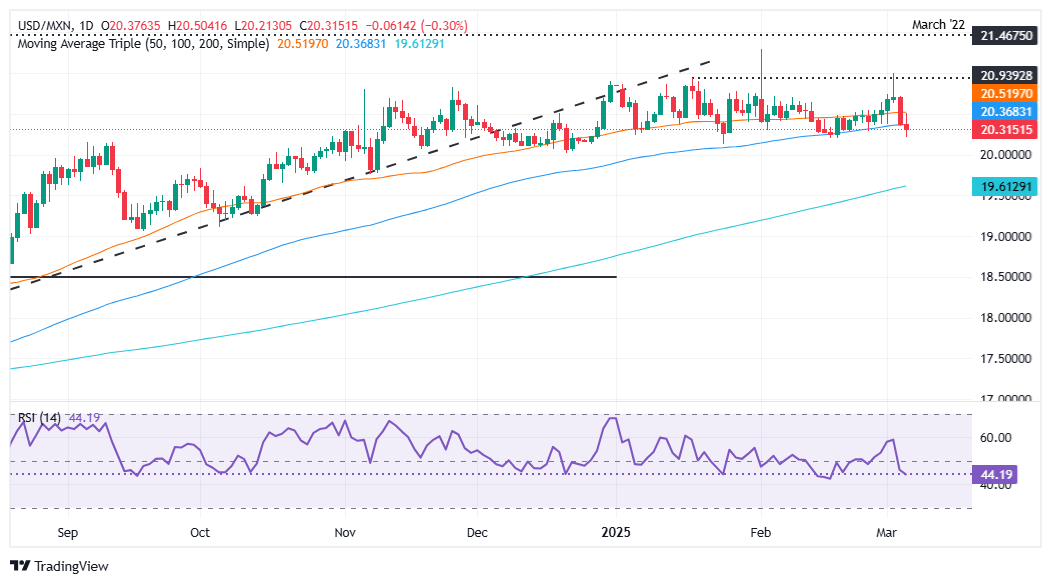Most recent article: Mexican Peso struggles to hold gains, loses ground versus USD
- Trump delays reciprocal tariffs on Mexico until April 2 after talks with Sheinbaum.
- USD/MXN briefly falls as tariff relief boosts MXN before rebounding above 20.30.
- Traders eye Mexico’s inflation data and US Nonfarm Payrolls for further direction.
The Mexican Peso (MXN) appreciated against the US Dollar (USD) on Thursday after United States (US) President Donald Trump said that Mexico would be exempt from paying tariffs on anything falling within the United States-Mexico-Canada Agreement (USMCA). The USD/MXN is trading at 20.26, down 0.55%.
Recently, Mexico’s President Claudia Sheinbaum called Trump and agreed on a delay of one month, until April 2, when reciprocal tariffs will begin. Trump posted on its social network “Our relationship has been a very good one, and we are working hard, together, on the Border, both in terms of stopping Illegal Aliens from entering the United States and, likewise, stopping Fentanyl.”
As the news broke, the USD/MXN pair retreated to a daily low of 20.21, beneath the 100-day Simple Moving Average (SMA) of 20.33. Since then, buyers have pushed the exchange rate above 20.30.
Traders are also eyeing the release of Mexico’s inflation figures for February. The Consumer Price Index (CPI) and Core CPI are expected to drop monthly. However, according to a Reuters poll, both readings will pick up yearly.
Meanwhile, US jobs data was mixed, with the number of people filing unemployment claims dipping compared to the previous reading, revealed the Department of Labor. The Challenger jobs report showed layoffs rose to levels not seen since the last two recessions due to mass federal government job cuts.
Ahead of this week, traders will watch the release of February Nonfarm Payrolls, which are expected to rise above January’s figures.
Daily digest market movers: Mexican Peso advances on positive trade news
- Mexico’s CPI for February is projected to dip by 0.27% MoM, down from 0.29%. In the twelve months to February, it would likely rise by 3.77%, up from 3.59%. Core CPI for the same period is projected to rise 0.46% MoM from 0.41%. Over one year, core prices are projected to drop from 3.66% to 3.62%.
- Banco de Mexico's (Banxico) private economists' survey showed that headline inflation is forecast to end at 3.71%, while core CPI is expected to finish at 3.75%. The USD/MXN exchange rate is projected to end at 20.85 in 2025, slightly lower than the 20.90 projection in the previous survey. However, for 2026, they anticipate a sharper depreciation of the Peso, well beyond the 21.30 level expected in January’s poll.
- US Initial Jobless Claims for the week ending March 1 increased by 221K, below estimates of 235K and last week’s 242K.
- Challenger Job Cuts in February soared from 49.795K to 172.017K, blamed on DOGE actions. Challenger, Gray & Christmas revealed that the government accounted for the bulk of the layoffs, for 62,242 job cuts by the federal government.
- Hence, money market traders had priced in 74 basis points of easing in 2025, up from Wednesday's 72 bps, via data from the Chicago Board of Trade (CBOT).
- Trade disputes between the US and Mexico remain front and center. If countries could come to an agreement, it could pave the way for a recovery of the Mexican currency. Otherwise, further USD/MXN upside is seen, as US tariffs could trigger a recession in Mexico.
USD/MXN technical outlook: Mexican Peso surges as USD/MXN drops below 20.40
USD/MXN continues to trade sideways, but sellers seem to have the upper hand. If the exotic pair prints a daily close below the 100-day SMA, a re-test of the 20.00 psychological figure is on the cards. A breach of the latter would expose the 200-day SMA at 19.54.
Otherwise, if USD/MXN climbs past the 100-day SMA, the next resistance would be 20.50. If surpassed, the next key resistance levels would be the March 4 peak at 20.99 and the year-to-date (YTD) peak of 21.28.
Mexican Peso FAQs
The Mexican Peso (MXN) is the most traded currency among its Latin American peers. Its value is broadly determined by the performance of the Mexican economy, the country’s central bank’s policy, the amount of foreign investment in the country and even the levels of remittances sent by Mexicans who live abroad, particularly in the United States. Geopolitical trends can also move MXN: for example, the process of nearshoring – or the decision by some firms to relocate manufacturing capacity and supply chains closer to their home countries – is also seen as a catalyst for the Mexican currency as the country is considered a key manufacturing hub in the American continent. Another catalyst for MXN is Oil prices as Mexico is a key exporter of the commodity.
The main objective of Mexico’s central bank, also known as Banxico, is to maintain inflation at low and stable levels (at or close to its target of 3%, the midpoint in a tolerance band of between 2% and 4%). To this end, the bank sets an appropriate level of interest rates. When inflation is too high, Banxico will attempt to tame it by raising interest rates, making it more expensive for households and businesses to borrow money, thus cooling demand and the overall economy. Higher interest rates are generally positive for the Mexican Peso (MXN) as they lead to higher yields, making the country a more attractive place for investors. On the contrary, lower interest rates tend to weaken MXN.
Macroeconomic data releases are key to assess the state of the economy and can have an impact on the Mexican Peso (MXN) valuation. A strong Mexican economy, based on high economic growth, low unemployment and high confidence is good for MXN. Not only does it attract more foreign investment but it may encourage the Bank of Mexico (Banxico) to increase interest rates, particularly if this strength comes together with elevated inflation. However, if economic data is weak, MXN is likely to depreciate.
As an emerging-market currency, the Mexican Peso (MXN) tends to strive during risk-on periods, or when investors perceive that broader market risks are low and thus are eager to engage with investments that carry a higher risk. Conversely, MXN tends to weaken at times of market turbulence or economic uncertainty as investors tend to sell higher-risk assets and flee to the more-stable safe havens.
Information on these pages contains forward-looking statements that involve risks and uncertainties. Markets and instruments profiled on this page are for informational purposes only and should not in any way come across as a recommendation to buy or sell in these assets. You should do your own thorough research before making any investment decisions. FXStreet does not in any way guarantee that this information is free from mistakes, errors, or material misstatements. It also does not guarantee that this information is of a timely nature. Investing in Open Markets involves a great deal of risk, including the loss of all or a portion of your investment, as well as emotional distress. All risks, losses and costs associated with investing, including total loss of principal, are your responsibility. The views and opinions expressed in this article are those of the authors and do not necessarily reflect the official policy or position of FXStreet nor its advertisers. The author will not be held responsible for information that is found at the end of links posted on this page.
If not otherwise explicitly mentioned in the body of the article, at the time of writing, the author has no position in any stock mentioned in this article and no business relationship with any company mentioned. The author has not received compensation for writing this article, other than from FXStreet.
FXStreet and the author do not provide personalized recommendations. The author makes no representations as to the accuracy, completeness, or suitability of this information. FXStreet and the author will not be liable for any errors, omissions or any losses, injuries or damages arising from this information and its display or use. Errors and omissions excepted.
The author and FXStreet are not registered investment advisors and nothing in this article is intended to be investment advice.
Recommended content
Editors’ Picks

Gold sits at fresh record high above $3,300 as US Dollar wilts on trade woes
Gold price remains within a striking distance of new record highs above $3,300 on Wednesday. Persistent worries about the escalating US-China trade war and US recession fears revive brroad US Dollar downtrend, boosting the traditional safe-haven Gold ahead of Fed Powell's speech.

EUR/USD holds firm above 1.1350 amid renewed US Dollar weakness
EUR/USD is storngly bid above 1.1350 in European trading on Wednesday. The pair draws support from a fresh round of selling in the US Dollar amid persistent fears over US-China trade war and a lack of progress on EU-US trade talks. US consumer data and Powell speech are in focus.

GBP/USD hangs close to fresh 2025-high above 1.3250 after UK CPI data
GBP/USD holds its six-day winning streak and stays close to its highest level since October above 1.3250 in the European session on Wednesday. The data from the UK showed that the annual CPI inflation softened to 2.6% in March from 2.8% in February but had little impact on Pound Sterling.

BoC set to leave interest rate unchanged amid rising inflation and US trade war
All the attention is expected to be on the Bank of Canada this Wednesday as market experts widely anticipate the central bank to maintain its interest rate at 2.75%, halting seven consecutive interest rate cuts.

Future-proofing portfolios: A playbook for tariff and recession risks
It does seem like we will be talking tariffs for a while. And if tariffs stay — in some shape or form — even after negotiations, we’ll likely be talking about recession too. Higher input costs, persistent inflation, and tighter monetary policy are already weighing on global growth.

The Best brokers to trade EUR/USD
SPONSORED Discover the top brokers for trading EUR/USD in 2025. Our list features brokers with competitive spreads, fast execution, and powerful platforms. Whether you're a beginner or an expert, find the right partner to navigate the dynamic Forex market.




